Continental Drift and Distribution of Animals | Zoology Optional Notes for UPSC PDF Download
Introduction
Continental drift is a groundbreaking theory that elucidates the dynamic process of continents shifting positions on Earth's surface. Proposed in 1912 by Alfred Wegener, a distinguished geophysicist and meteorologist, this theory not only addresses the movement of continents but also provides insights into the distribution of similar fossils and rock formations across different continents.Continental Drift Theory by Alfred Wegener
- Alfred Wegener introduced the Continental Drift Theory in the 1920s.
- The core concept suggests the existence of a supercontinent named Pangaea, enveloped by a vast ocean known as Panthalassa.
- Pangaea was divided into two colossal landmasses: Laurentia (Laurasia) to the north and Gondwanaland to the south, separated by the Tethys sea.
- The drift commenced approximately 200 million years ago during the Mesozoic Era, specifically in the Triassic Period's Late Triassic Epoch, leading to the gradual separation of continents.
Forces Behind Continental Drift
According to Wegener, the drift occurred in two directions:- Equatorwards: Resulting from the interaction of gravity, pole-fleeing force (caused by the earth's rotation), and buoyancy.
- Westwards: Caused by tidal currents generated by the earth's rotational motion.
- Wegener emphasized the role of tidal forces, primarily induced by the gravitational pull of the moon and, to a lesser extent, the sun.
- The polar-fleeing force is linked to the earth's non-spherical shape, with a bulge at the equator due to its rotation.
Evidence Supporting Continental Drift
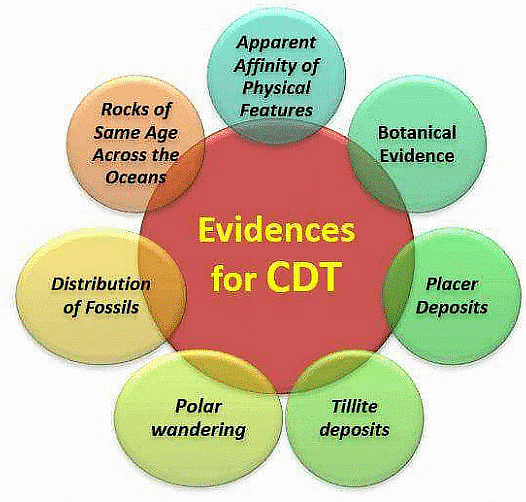
Apparent Affinity of Physical Features
- The bulge of Brazil fitting into the Gulf of Guinea.
- Greenland aligning well with Ellesmere and Baffin islands of Canada.
- Suggestive connections between the west coast of India, Madagascar, and Africa.
- Alignment of North and South America with Africa and Europe along the mid-Atlantic ridge.
- Geological continuity observed in the Caledonian and Hercynian mountains of Europe and the Appalachians of the USA.
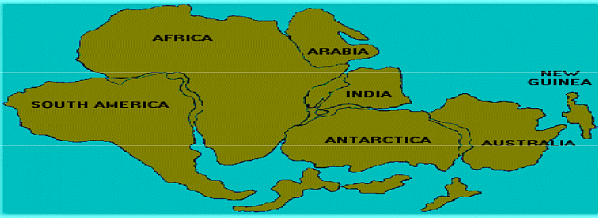
Criticism of Continental Drift Theory
- Coastlines are considered temporary and subject to change.
- Various unrelated landforms could be manipulated to fit together.
- The theory misplaces India too far south, distorting its relationship with the Mediterranean Sea and the Alps.
- Geological affinity is not always evident in mountain formations.
Causes of Drift
- Wegener attributed continental drift to the combined effects of Earth's gravity, buoyancy of seas, and tidal currents.
Criticism of Causes
- Critics argue that these factors, for such a magnitude of drift, would need to be millions of times stronger.
Polar Wandering (Shifting of Poles)
- Wegener noted the constant drift in the position of the poles, attributing it to plate tectonics.
Criticism of Polar Wandering
- Critics argue that while poles may shift, it doesn't necessarily imply continental movement.
Botanical Evidence in Support of Continental Drift
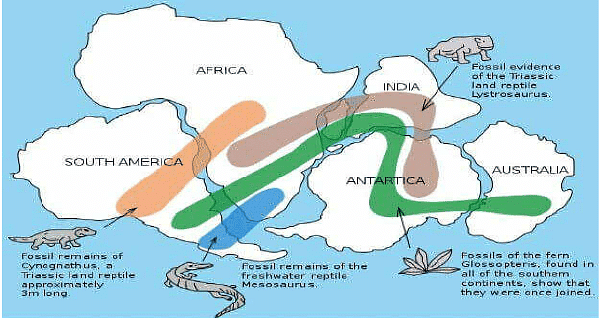
Alfred Wegener’s theory of continental drift, proposed in the early 20th century, was a pioneering idea suggesting that continents were once part of a supercontinent called Pangaea and have since drifted apart. His theory was supported by various lines of evidence, particularly botanical and fossil findings, but it also faced significant criticism and limitations.
Botanical and Fossil Evidence Supporting Continental Drift
Glossopteris Vegetation:- Glossopteris was a type of seed fern that lived during the late Paleozoic era. Fossils of Glossopteris have been found in Carboniferous rocks in widely separated regions, including India, Australia, South Africa, the Falkland Islands, and Antarctica.
- The widespread distribution of Glossopteris suggested that these continents were once connected, forming the ancient supercontinent Gondwana. The presence of similar vegetation across these regions supported the idea of a shared botanical history before the continents drifted apart.
- However, criticism arose when similar vegetation was also found in areas like Afghanistan, Iran, and Siberia, which seemed unrelated to Gondwana, raising questions about the universality of this evidence.
Fossil Distribution:
- Fossils of the small, freshwater reptile Mesosaurus have been found in both South Africa and Brazil. Since Mesosaurus lived in shallow, brackish water, the discovery of its fossils on two continents now separated by the Atlantic Ocean suggested that these regions were once connected.
- Similarly, observations of lemur fossils in India, Madagascar, and Africa led to the hypothesis of a lost landmass called "Lemuria," which was believed to have connected these areas. This further supported the idea of a connected landmass.
- Despite this, the discovery of similar fossils in unrelated regions posed challenges to the interpretation of this evidence, raising doubts about the direct connection between these areas.
Polar Wandering:
- The concept of polar wandering, where the magnetic poles of the Earth seemed to shift over time, provided additional support for continental movement. This theory suggested that the apparent movement of the poles could be explained by the shifting positions of the continents.
- Critics, however, argued that the poles might have shifted independently of continental movement, questioning whether this phenomenon directly supported the theory of continental drift.
Rocks of the Same Age:
- Wegener pointed out that ancient rocks, particularly those around 2 billion years old, found along the coast of Brazil, closely matched those found in western Africa. This similarity in rock formations suggested that these continents were once part of a single landmass.
- However, the discovery of rocks of similar age and characteristics in other regions around the world complicated this evidence, as it indicated that such similarities could be coincidental rather than indicative of a past connection.
Tillite Deposits:
- Tillite is a type of sedimentary rock formed from glacial deposits. Tillite deposits found in Gondwana regions like India, Africa, the Falkland Islands, Madagascar, Antarctica, and Australia provided strong evidence of a common glacial history.
- The shared geological features implied that these land masses were once part of the same continent, which experienced extensive glaciation before drifting apart.
Placer Deposits:
- Placer deposits of gold found along the coast of Ghana were traced back to their source in Brazil, suggesting that these continents were once adjacent. The presence of such mineral deposits indicated that the Brazil plateau may have contributed to Ghana's mineral wealth, further supporting the idea of continental drift.
Drawbacks of Continental Drift Theory
Despite the compelling evidence, Wegener’s theory faced several significant criticisms:Timing of Drift:
- Wegener’s theory did not adequately explain why the continental drift began during the Mesozoic era and not earlier. This lack of temporal specificity was a major shortcoming.
Role of Oceans:
- The theory overlooked the role of oceans in the movement of continents. Wegener’s focus was primarily on the continents themselves, neglecting the dynamic interactions between oceans and landmasses.
Reliance on General Assumptions:
- Much of the evidence Wegener used relied on broad assumptions, such as the similarity of fossils and geological formations across continents. Critics argued that these assumptions were not sufficient to prove the theory conclusively.
Inadequate Mechanism:
- Wegener proposed that factors like Earth's gravity, the buoyancy of the seas, and tidal currents were responsible for continental drift. However, these forces were considered too weak to drive the massive movements of continents.
Legacy and Modern Perspectives
While Wegener’s theory of continental drift was initially met with skepticism, it laid the groundwork for the development of more advanced theories such as plate tectonics. Plate tectonics provided a more comprehensive explanation for the movement of continents, incorporating the roles of oceanic and continental plates, seafloor spreading, and the mechanisms driving these processes. Despite its limitations, Wegener’s theory was a significant milestone in the understanding of Earth's geological history and the dynamic nature of its surface.
Law of Tolerance - Shelford's Law
Basics of Shelford's Law
- Focus on minimal limiting factors affecting growth or biological processes.
- Shelford's Law introduces the concept that excess/abundance of a factor can also affect growth or biological processes.
Law of Tolerance
- Growth and development of organisms depend on maximum and minimum limits of factors.
- Two zones in environmental factors: Zone of Intolerance and Zone of Tolerance.
Subdivisions of Zone of Tolerance
Optimal Zone:
- Most favorable for maximum growth and development of organisms.
Critical Minimum Zone:
- Lowest limit inhibiting organism growth.
Critical Maximum Zone:
- Maximum limit beyond which organism growth ceases.
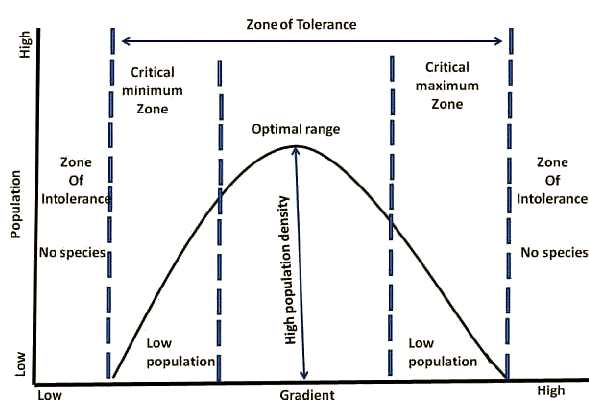
Importance of Tolerance
- Organisms with a wide range of tolerance and broad distribution range survive best.
- Understanding environmental factors crucial for determining the Zone of Tolerance.
Animal Distribution
Types and Patterns
1. Distribution in Space
(i) Geographical or Horizontal Distribution
- Refers to the arrangement of animals on Earth's surface.
- Involves distribution on land and in different continents and islands.
(ii) Bathymetric or Vertical Distribution
- Concerns the distribution of animals on the vertical surface of land and water.
- Subdivided into:
- (a) Limnobiotic Distribution: Freshwater sources.
- (b) Holobiotic Distribution: Sea.
- (c) Geobiotic Distribution: Land.
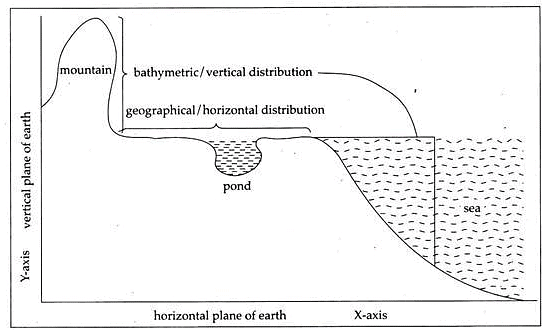
2. Distribution in Time
- Examines the distribution of animals in Earth's past, studied through fossil evidence.
- Described on the Geological time scale.
Patterns of Distribution
(a) Arctic Distribution
- Species inhabit Arctic or Antarctic waters with no representatives in intermediate oceans.
- Known as bipolar distribution, characterized by bipolarity.
Examples:
- Coelenterats: Botrynema, Grammaria, Lampta, Myriothela
- Molluscs: Limacina helicina, Clione
- Arthropoda: Peripatus
- Fishes: Oncorhynchus (salmon), Latnma cornubica
- Birds: Aptenodytes (Penguin)
- Mammals: Balaenoptera musculus (blue whale), Callorhinus (Seal), Caribou, etc.
(b) Tropical Distribution
- Animals between Tropic of Cancer and Tropic of Capricorn.
- Maximum biodiversity in this region.
- Detailed faunal distribution under Oriental, Neo-tropical, and Ethiopian realms.
(c) Continuous Distribution
- Also called cosmopolitan distribution.
- Animals found over a wide, uninterrupted range.
Examples:
Mollusca: The green mussel (Mytilus)
Arthropoda: Brine shrimp (Artemia salina), cockroach (Periplaneta)
Birds: Hawks, cuckoo
Mammals: Rats, bats, etc.
Eurytopic animals thrive over a large range, e.g., cockroach.
Stenotopic animals are restricted to a definite area, e.g., Peripatus in arctic areas.
(d) Discontinuous Distribution
- Different species of the same genus or different members of a species live in different parts of the earth.
Origin of Discontinuous Distribution
- Theories by P. J. Darlington and P. B. Weitz accepted.
- Darlington proposes reasons like reaching oceanic islands, submergence of landmass, and extinction in intermediate areas.
- Weitz suggests continuous or discontinuous distribution through sweeps take bridges, filter bridges, and corridor bridges.
Examples:
Sweeps Take Bridges:
- Floating ice, logs, mud on bird's claw facilitating animal transport.
- Madagascar's animals transported from Africa via sweeps take bridges.
Filter Bridges:
- Narrow land connection filtering organisms, often existing briefly.
- Connection between North and South America during the late Mesozoic era, affecting marsupials and other mammals.
Corridor Bridges:
- Broad land connection allowing substantial exchange of species.
- Europe and Asia linked by a corridor bridge during the tertiary period, affecting faunal composition.
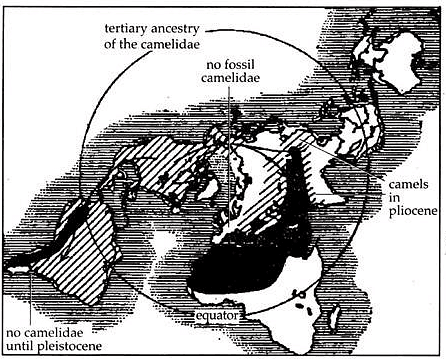
In conclusion, understanding animal distribution involves recognizing spatial and temporal patterns, each influenced by geographical, environmental, and historical factors. The various distribution types and patterns offer insights into the diverse ways animals adapt to their surroundings and evolve over time.
|
181 videos|351 docs
|
FAQs on Continental Drift and Distribution of Animals - Zoology Optional Notes for UPSC
| 1. What is the Continental Drift Theory proposed by Alfred Wegener? |  |
| 2. What evidence supports the Continental Drift Theory? |  |
| 3. What are some criticisms of the Continental Drift Theory? |  |
| 4. How does botanical evidence support Continental Drift? |  |
| 5. What are some drawbacks of the Continental Drift Theory? |  |
















